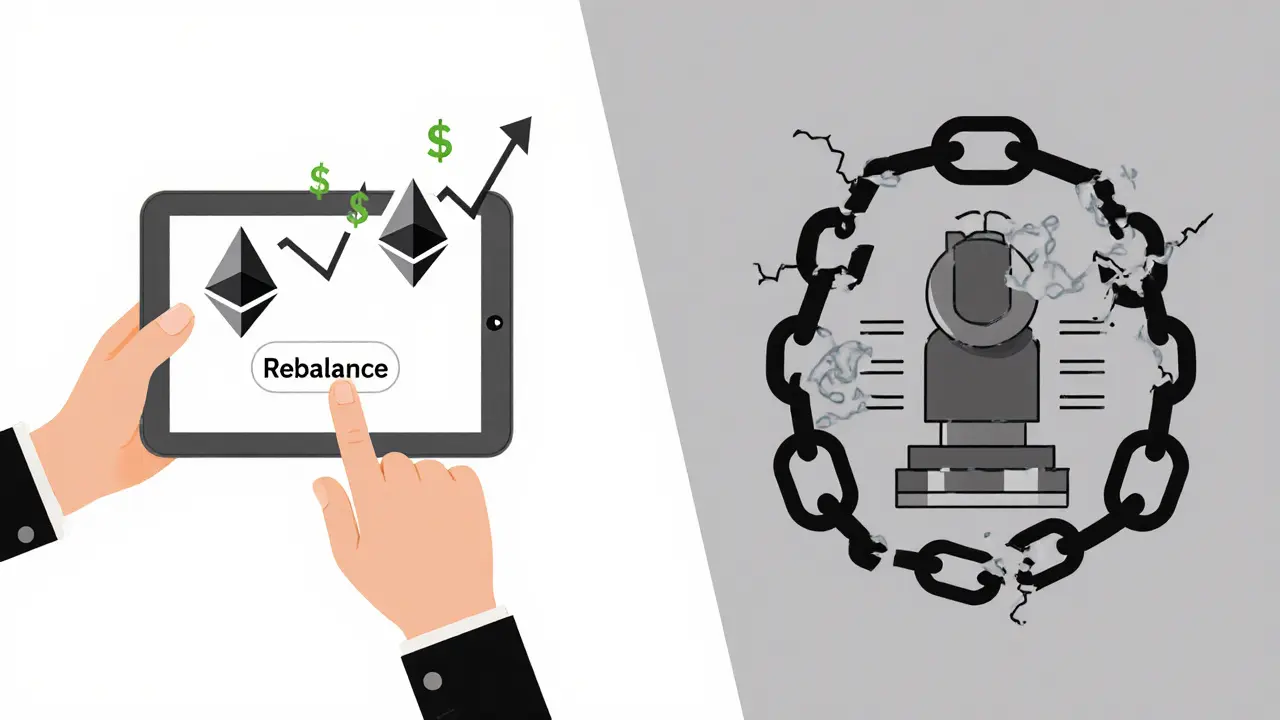What is Memento (DEXTF) Crypto Coin? A Simple Guide to the Decentralized ETF Protocol
 Nov, 11 2025
Nov, 11 2025
Memento Gas Fee Calculator
Gas Fee Estimator
Results
Gas Fee:
$0.00
Percentage of Fund:
0.00%
Tip: Memento's Layer 2 upgrade (Optimism) in Q4 2023 could reduce fees to under $1. Stay tuned for major cost savings!
Memento (DEXTF) isn't just another crypto coin. It's a system designed to let anyone create their own crypto investment fund-no finance degree or coding skills needed. Think of it like building a custom mutual fund, but entirely on the blockchain, with no middlemen. The DEXTF token powers this whole setup. It’s not a currency you spend at coffee shops. It’s the engine that makes decentralized ETFs work.
How Memento (DEXTF) Actually Works
Memento runs on Ethereum as an ERC20 token. Its contract address is 0x5f64ab1544d28732f0a24f4713c2c8ec0da089f0. But the real magic isn’t in the token itself-it’s in what you can do with it. The protocol lets users create something called XTF funds. Each XTF fund is its own ERC20 token, with its own smart contract. You can pick up to 15 different cryptocurrencies (like ETH, BTC, LINK, UNI) and bundle them into one fund. Then you can let others invest in it.
Unlike traditional ETFs managed by banks, Memento’s funds are created and run by regular people. A portfolio manager sets the rules: which tokens to include, how much of each, and what fee to charge investors (usually between 0.25% and 0.75% per year). Once the fund is live, anyone can buy shares in it just like buying any other crypto token.
The big twist? Memento avoids oracles entirely. Most DeFi protocols rely on oracles to get real-time prices for rebalancing funds. But oracles can be hacked, manipulated, or fail. Memento says: don’t trust outside data. Instead, it uses simple, on-chain logic that only updates when users manually trigger a rebalance. This makes the system more secure-but also means funds don’t auto-adjust. You’re responsible for keeping your fund balanced.
Why Memento Stands Out from the Competition
There are other decentralized ETF projects like Index Coop and PieDAO. Index Coop has more funds, more tokens, and bigger market cap-$28.7 million vs. Memento’s $9.4 million. But Memento wins on simplicity.
Index Coop’s funds use complex rebalancing logic that needs oracles and admin keys. If something goes wrong, someone has to step in and fix it. Memento doesn’t have admin keys. No one can freeze your fund. No one can change the rules after it’s live. That’s a huge deal for people who care about true decentralization.
Also, creating a fund on Memento takes under five minutes. On Index Coop, it’s often a longer, more bureaucratic process. If you’re a retail investor or a small-time portfolio manager who wants to launch a fund fast, Memento gives you the tools without the red tape.
But there’s a trade-off. Because Memento doesn’t auto-rebalance, your fund can drift. If you create a fund with 50% ETH and 50% UNI, and ETH shoots up 200%, your fund is now 80% ETH. You have to manually rebalance it-or your investors get uneven exposure. That’s a problem for beginners who don’t know how to monitor their funds.

DEXTF Token: Supply, Price, and Where to Buy
There are 65.8 million DEXTF tokens in circulation out of a max supply of 100 million. The total supply is nearly 99.99 million. That means most of the tokens are already out there.
Price data varies by exchange. CoinMarketCap shows DEXTF trading around $0.3059, while Coinbase reports $0.14. This gap happens because DEXTF is listed on only seven major exchanges: Coinbase, Gate.io, MEXC, KuCoin, Bitrue, Hoo, and Bitget. Prices differ because of liquidity and trading volume. The 24-hour volume ranges from $94,000 to $550,000, depending on the source.
To buy DEXTF, you need to:
- Create an account on one of the supported exchanges (Coinbase or Gate.io are easiest for beginners).
- Verify your identity (takes 15-45 minutes).
- Deposit USDT, ETH, or another major crypto.
- Search for DEXTF and place your order.
Don’t buy DEXTF from random websites or peer-to-peer sellers. Stick to the exchanges listed on CoinMarketCap. Scammers often create fake tokens with similar names.
Gas Fees Are the Real Cost
Here’s the catch: buying DEXTF is cheap. Creating a fund? That’s where it hurts.
Every time you create or rebalance a fund on Memento, you pay Ethereum gas fees. In May 2023, those fees averaged $15.75 per transaction. One user paid $22 to create a $100 fund. That’s a 22% fee before the fund even starts earning.
That’s why most users are either:
- Investors with $5,000+ who can absorb the cost,
- Or portfolio managers who create multiple funds and spread the cost across them.
Small investors with under $500 rarely use Memento. The gas fees make it uneconomical. That’s why 68% of users have portfolios under $5,000-they’re not creating funds. They’re just buying into existing ones.
The Memento team knows this. Their v2.1 upgrade in June 2023 cut gas costs by 22%. And they’re planning to move to Optimism (an Ethereum Layer 2) in Q4 2023. That could slash fees to under $1 per transaction. If that happens, Memento could explode in popularity.

Who Uses Memento-and Why
Most users are retail investors. They don’t want to pick individual coins. They want a diversified basket. Some use Memento to create niche funds: “AI Crypto Tokens,” “DeFi Yield Protocols,” “Stablecoin + ETH.” Others copy popular funds from Reddit or Twitter.
There’s a success story on Reddit: one user created a fund with 8 DeFi yield tokens and earned 23.7% annual returns over six months. But there’s also a failure: another user created a fund with 10 tokens, didn’t rebalance, and lost 41% when one token crashed.
The community is small but active. The official Discord has 2,847 members. The YouTube channel has 37 tutorials with over 1,800 hours of watch time. There’s even a 147-item FAQ. If you’re confused, help is there.
But don’t expect Wall Street adoption. Institutional investors haven’t touched Memento. The SEC hasn’t clarified whether XTF funds are securities. If they are, regulators could shut them down. That’s a risk.
Is Memento (DEXTF) Worth It?
It depends on what you want.
If you’re a tech-savvy investor who wants:
- Full control over your investments,
- Zero reliance on centralized admins,
- And the ability to create your own crypto fund,
Then Memento is one of the few tools that lets you do it-right now.
If you’re looking for:
- Automatic rebalancing,
- Low fees for small investments,
- Or a fund that grows on its own,
Then stick with Index Coop-or wait for Memento’s Layer 2 upgrade.
DEXTF isn’t going to make you rich overnight. But it’s a rare example of a DeFi project that’s actually solving a real problem: giving everyday people the power to build financial products without permission. That’s powerful.
The road ahead is rough. Gas fees are still too high. Regulatory clouds loom. And market share is tiny. But if Memento pulls off its Layer 2 move, it could become the go-to platform for retail fund creators. Right now, it’s a niche tool. In two years, it might be essential.
What is the DEXTF token used for?
DEXTF is the utility token for the Memento protocol. It’s used to create, manage, and interact with decentralized ETF funds (XTF funds). Users pay gas fees in ETH to create funds, but DEXTF is required to participate in governance and access certain features like fund analytics and premium tools. It’s not a currency for payments-it’s the key to the system.
Can I create my own crypto fund with Memento?
Yes. You can create your own XTF fund in under five minutes using the Memento interface. You choose up to 15 tokens, set your fee (0.25%-0.75%), and launch it. Anyone can then buy shares in your fund. You don’t need to code. But you’re responsible for rebalancing it manually when needed.
Why is DEXTF’s price so different on Coinbase vs. CoinMarketCap?
Prices vary because DEXTF trades on only seven exchanges, and liquidity differs across them. Coinbase may have lower trading volume, so its price reflects fewer trades. CoinMarketCap pulls data from multiple exchanges and weights them, which can result in a higher or more accurate price. Always check the trading pair and exchange before buying.
Are Memento funds safe?
The Memento smart contracts have been audited by CertiK and fixed three medium-severity issues in 2023. No major exploits have occurred since. However, safety depends on you. If you create a fund with bad tokens or don’t rebalance, your investors can lose money. The protocol is secure-but your fund’s performance isn’t guaranteed.
Is Memento regulated by the SEC?
It’s unclear. The SEC hasn’t taken action yet, but its April 2023 framework suggests that funds offering passive returns and pooled assets could be classified as securities. If regulators decide Memento funds are securities, the platform could be forced to shut down or require licenses. That’s the biggest risk right now.
What’s next for Memento (DEXTF)?
The roadmap includes moving to Optimism (Ethereum Layer 2) by Q4 2023 to cut gas fees, adding cross-chain support in Q1 2024, and launching a formal governance system in Q2 2024. If successful, these upgrades could make Memento accessible to small investors and position it as a leader in decentralized fund creation.